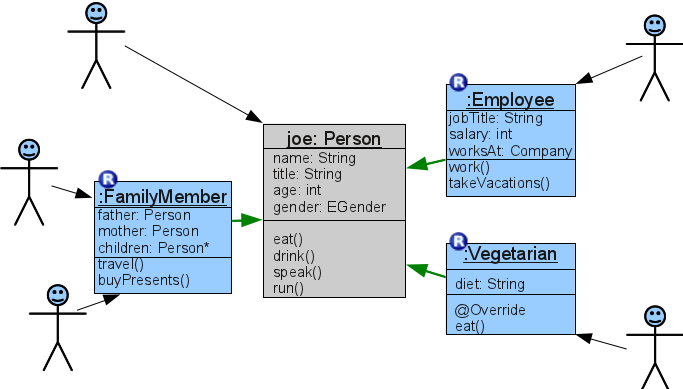The Essence of Object Teams
When I write about Object Teams and OT/J I easily get carried away indulging in cool technical details. Recently in the Object Teams forum we were asked about the essence of OT/J which made me realize that I had neglected the high-level picture for a while. Plus: this picture looks a bit different every time I look at it, so here is today’s answer in two steps: short and extended.
Short version:
Extended version:
In software design, e.g., we are used to describing a system from multiple perspectives or views, like: structural vs. behavioral views, architectural vs. implementation views, views focusing on distribution vs. business logic, or just: one perspective per use case.

A collage of UML diagrams
© 2009, Kishorekumar 62, licensed under the Creative Commons Attribution-Share Alike 3.0 Unported license.
In regular OO programming this is not well supported, an object is defined by exactly one class and no matter from which perspective you look at it, it always has the exact same properties. The best we can do here is controlling the visibility of methods by means of interfaces.
By contrast, in OT/J you start with a set of lean base objects and then you may attach specific roles for each perspective. Different use cases and their scenarios can be implemented by different roles. Visualization in the UI may be implemented by another independent set of roles, etc.
Code-level comparison?
I’ve been asked to compare standard OO and OT/J by direct comparison of code examples, but I’m not sure if it is a good idea to do, because OT/J is not intended to just provide a nicer syntax for things you can do in the same way using OO. OT/J – as any serious new programming language should do IMHO – wants you to think differently about your design. For example, we can give an educational implementation of the Observer pattern using OT/J, but once you “think Object Teams” you may not be interested in the Observer pattern any more, because you can achieve basically the same effect using a single callin binding as shown in our Stopwatch example.
So, positively speaking, OT/J wants you to think in terms of perspectives and make the perspectives you would naturally use for describing the system explicit by means of roles.
OTOH, a new language is of course only worth the effort if you have a problem with existing approaches. The problems OT/J addresses are inherently difficult to discuss in small examples, because they are:
- software complexity, e.g., with standard OO finding a suitable decomposition where different concerns are not badly tangled with each other becomes notoriously difficult.
- software evolution, e.g., the initial design will be challenged with change requests that no-one can foresee up-front.
(Plus all the other concerns addressed)
Both, theory and experience, tell me that OT/J excels in both fields. If anyone wants to challenge this claim using your own example, please do so and post your findings, or lets discuss possible designs together.
One more essential concept
I should also mention the second essence in OT/J: after slicing elements of your program into roles and base objects we also support to re-group the pieces in a meaningful way: as roles are contained in teams, those teams enable you to raise the level of abstraction such that each user-relevant feature, e.g., can be captured in exactly one team, hiding all the details inside. As a result, for a high-level design view you no longer have to look at diagrams of hundreds of classes but maybe just a few tens of teams.
Hope this helps seeing the big picture. Enough hand-waving for today, back to the code! 🙂



Leave a comment